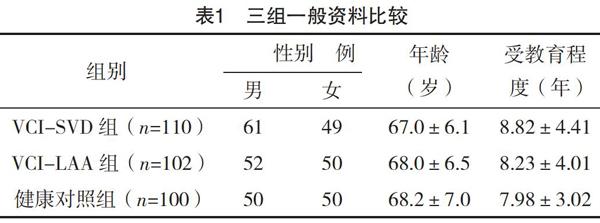小血管病性认知障碍与大动脉粥样硬化性认知障碍危险因素差异的研究
安晓雷 李传玲 郭靖 欧春影 李晓宾 许可



【摘要】 目的:探討小血管病性认知障碍(vascular cognitive impairment due to small vessel disease,VCI-SVD)与大动脉粥样硬化性认知障碍(vascular cognitive impairment due to large artery atherosclerosis,VCI-LAA)的危险因素差异及临床意义。方法:回顾分析110例VCI-SVD患者与102例VCI-LAA患者的人口学资料及血管危险因素,分别与100例健康体检者比较,采用多因素logistic回归分析,得到VCI-SVD与VCI-LAA的独立危险因素,并比较其不同。结果:VCI-SVD组的高hs-CRP血症、高Hcy血症、糖尿病、高血压、吸烟及饮酒比例均高于健康对照组,差异均有统计学意义(P<0.05)。VCI-LAA
组高血压、脑卒中史、房颤、吸烟及饮酒比例均高于健康对照组,差异均有统计学意义(P<0.05)。logistic回归分析显示,糖尿病、高hs-CRP血症、高Hcy血症、高血压、吸烟、饮酒是VCI-SVD特有的独立危险因素(P<0.05);房颤、脑卒中史、高血压、吸烟、饮酒是VCI-LAA特有的独立危险因素(P<0.05)。结论:VCI-SVD与VCI-LAA的危险因素存在差异,针对两种类型的认知障碍的危险因素进行有针对性的干预,能延缓或减少血管性认知障碍的出现。
【关键词】 小血管病性认知障碍; 大动脉粥样硬化性认知障碍; 危险因素
Study on the Difference of Risk Factors between Small Vascular Cognitive Impairment and Large Atherosclerotic Cognitive Impairment/AN Xiaolei,LI Chuanling,GUO Jing,et al.//Medical Innovation of China,2019,16(27):00-004
【Abstract】 Objective:To investigate the differences of risk factors and clinical significance between the VCI-SVD and VCI-LAA.Method:The demographic data and vascular risk factors of 110 patients with VCI-SVD and 102 patients with VCI-LAA were retrospectively analyzed and compared with 100 healthy people.Independent risk factors of VCI-SVD and VCI-LAA were obtained by multivariate logistic regression analysis,and their differences were compared.Result:The proportion of high hs-CRP,high Hcy,diabetes,hypertension,smoking and drinking in the VCI-SVD group were higher than those in the healthy control group,the differences were statistically significant(P<0.05).The proportion of hypertension,stroke history,atrial fibrillation,smoking and drinking in the VCI-LAA group were higher than those in the healthy control group,with statistically significant differences(P<0.05).Logistic regression analysis showed that diabetes,high hs-CRP,high Hcy,hypertension,smoking and drinking were independent risk factors specific to VCI-SVD(P<0.05).Atrial fibrillation,stroke history,hypertension,smoking and alcohol consumption were independent risk factors specific to VCI-LAA(P<0.05).Conclusion:The risk factors of VCI-SVD and VCI-LAA are different,targeted interventions for the risk factors of the two types of cognitive impairment can delay or reduce the occurrence of vascular cognitive impairment.
【Key words】 Vascular cognitive impairment due to small vessel disease; Vascular cognitive impairment due to large artery atherosclerosis; Risk factors
First-authors address:Xuzhou Central Hospital,Xuzhou 221009,China
doi:10.3969/j.issn.1674-4985.2019.27.001
随着脑血管病患者不断增多,血管性认知障碍(vascular cognitive impairment,VCI)患病率呈逐年遞增趋势。VCI是指由血管因素导致从轻度认知障碍到痴呆的一类综合征[1]。文献[2]研究发现,大动脉粥样硬化(large artery atherosclerosis,LAA)和小血管病(small vessel disease,SVD)是导致VCI的两大最重要原因。目前对于VCI危险因素的研究大都集中在大动脉粥样硬化性认知障碍(vascular cognitive impairment due to large artery atherosclerosis,VCI-LAA),而有关小血管病性认知障碍(vascular cognitive impairment due to small vessel disease,VCI-SVD) 的危险因素研究甚少。由于病理生理上的差异,VCI-SVD的危险因素与VCI-LAA的危险因素又有所不同[3-4]。本研究旨在探讨VCI-SVD与VCI-LAA危险因素的差异,为临床上对于两种认知障碍采取有针对性的预防措施提供参考。现将研究结果报道如下。
1 资料与方法
1.1 一般资料 选取2010年3月-2014年12月就诊于徐州市中心医院神经科门诊及住院的VCI患者212例,平均年龄(68.4±7.6)岁。纳入标准:存在认知障碍,蒙特利尔认知评估(Montreal cognitive assessment,MoCa)评分≥26分[5-6];所有患者均接受CT或MRI检查。排除标准:脑出血;汉密尔顿抑郁量表<17分;抑郁症;意识障碍;有感染性、中毒、脑外伤后、硬膜下血肿、颅内占位性病变、代谢营养障碍性疾病等致认知异常者。根据TOAST分型法分型[7],其中LAA型102例,SVD型110例。另选取同期健康对照100例。所有受试者均是自愿参加本研究,并签署知情同意书。
1.2 方法 收集患者的人口学及临床资料,包括年龄、教育年限、性别、烟酒嗜好、高血压、糖尿病、血脂、房颤、Hcy、hs-CRP。所有研究对象均空腹测定Hcy、hs-CRP、血糖、血脂。
1.3 血管性危险因素的诊断标准 高血压:收缩压≥140 mm Hg和/或舒张压≥90 mm Hg[8]。糖尿病:2次空腹血糖>6.1 mmol/L,或2次随机空腹血糖>7.0 mmol/L[9]。高脂血症:高脂血症诊断采用1997年《血脂异常防治建议》[10],血清总胆固醇≥5.7 mmol/L,或甘油三酯≥1.71 mmol/L,或低密度脂蛋白胆固醇≥3.64 mmol/L。高Hcy血症:血Hcy≥15 μmol/L。高hs-CRP血症:hs-CRP>3 mg/L。
吸烟:几乎每日吸烟,平均1支/d以上,时间>1年。饮酒:每周>13次,平均50 g/d以上,时间>1年。
1.4 观察指标 比较两组患者与健康体检者的人口学资料、血管危险因素。
1.5 统计学处理 采用SPSS 15.0软件对所得数据进行统计分析,计量资料用(x±s)表示,比较采用t检验;计数资料以率(%)表示,比较采用字2检验,多因素采用非条件logistic回归分析。P<0.05为差异有统计学意义。
2 结果
2.1 VCI-SVD组、VCI-LAA组与健康对照组人口学一般资料比较 三组患者的性别、年龄、受教育程度比较,差异均无统计学意义(P>0.05),具有可比性,见表1。
2.2 VCI-SVD组与健康对照组血管性危险因素比较 VCI-SVD组的高hs-CRP血症、高Hcy血症、糖尿病、高血压、吸烟及饮酒比例均高于健康对照组,差异均有统计学意义(P<0.05);两组高脂血症、脑卒中史、房颤情况比较,差异均无统计学意义(P>0.05)。见表2。
2.3 VCI-LAA组与健康对照组血管性危险因素比较 VCI-LAA组高血压、脑卒中史、房颤、吸烟及饮酒比例均高于健康对照组,差异均有统计学意义(P<0.05);两组高hs-CRP血症、高Hcy血症、高脂血症、糖尿病比较,差异均无统计学意义(P>0.05)。见表3。
2.4 非条件logistic回归分析 将单因素分析有统计学意义的指标作为自变量,VCI-SVD及VCI-LAA为因变量,用逐步引入方法分别代入logistic方程进行多因素分析。结果显示,在校正了其他因素后,糖尿病[OR=2.08,95%CI(1.32,4.85),P<0.05]、高hs-CRP血症[OR=2.24,95%CI(1.38,3.91),P<0.05]、高Hcy血症[OR=2.42,95%CI(1.23,5.62),P<0.05]、高血压[OR=2.13,95%CI(1.22,3.65),P<0.05]、吸烟[OR=3.20,95%CI(1.03,2.23),P<0.05]、饮酒[OR=2.92,95%CI(1.08,4.75),P<0.05]是VCI-SVD特有的独立危险因素;房颤[OR=2.15,95%CI(1.89,3.34),P<0.05]、脑卒中史[OR=3.03,95%CI(1.23,3.58),P<0.05]、高血压[OR=2.04,95%CI(1.02,4.03),P<0.05]、吸烟[OR=2.72,95%CI(1.11,3.29),P<0.05]、饮酒[OR=2.30,95%CI(1.03,4.08),P<0.05]是VCI-LAA特有的独立危险因素。
3 讨论
根据病因及临床表现,VCI可分为两大类:急性起病的VCI-LAA和慢性隐袭起病的VCI-SVD,两者的临床特征及危险因素均有明显的区别[11]。本研究显示,高血压、饮酒及吸烟是VCI-LAA和VCI-SVD的独立危险因素(P<0.05)。分析原因可能如下:VCI-SVD导致深穿支脑小动脉病变,脑小动脉位于血液循环的最末端,与神经细胞进行物质能量交换,烟酒嗜好及高血压病患者可促进脑小动脉平滑肌细胞纤维素样变性,管壁增厚、管腔狭窄,导致供血区白质缺血性脱髓鞘,从而影响脑组织血液灌注而导致认知障碍[12-14]。烟酒嗜好及高血压病患者也可导致大动脉粥样硬化加速,导致大动脉血管壁增厚、狭窄,附壁血栓形成[15],或者促进大动脉粥样硬化性脑梗死,相应供血区脑组织缺血缺氧从而发生VCI。本研究结果发现两种认知障碍组中高血压患者比例仍然有差别,VCI-SVD组高血压比例高于VCI-LAA组。分析可能的原因是大动脉粥样硬化患者通常伴有神经功能缺损,患者对于血压重视程度较高,而小血管病一般起病缓慢,多数患者在出现临床症状前不重视血压的调整;另一种可能的原因是脑小血管病变导致血压代偿性增高。
hs-CRP是一种具有免疫识别和免疫调节功能的蛋白,国外研究者认为其机制是通过减少一氧化氮的产生、促进小血管平滑肌细胞增生、促进单核细胞聚集、激活补体系统等多途徑造成内皮细胞损害,从而损害认知功能[16-18]。笔者也认为hs-CRP可能通过直接或间接的作用导致血管内皮的损害,造成VCI-SVD。本研究发现,VCI-SVD组的高hs-CRP血症比例高于VCI-LAA组。除此之外进一步校正房颤、高血压、糖尿病、高脂血症等相关因素后发现hs-CRP水平升高是VCI-SVD的独立危险因素(P<0.05),但并非VCI-LAA的独立危险因素。
血糖是VCI明确的影响因素,糖尿病引起血管基底膜增厚生化代谢紊乱,最终造成认知功能损害[19-21]。本研究发现糖尿病是VCI-SVD的独立危险因素(P<0.05),并非VCI-LAA的独立危险因素。分析其原因一方面由于糖尿病更容易造成脑微小血管病变;另一方面可能是由于LAA患者对于血糖更加重视,对于血糖控制更为严格。
目前认为Hcy诱发VCI的机制:Hcy产生自由基直接损伤血管内皮细胞,改变内皮细胞的基因表达,内皮细胞释放血管舒张因子功能障碍,血管内皮舒张功能受损[12-13,22-23],从而导致VCI-SVD。本研究证实Hcy是VCI-SVD的独立危险因素(P<0.05),但并非VCI-LAA的独立危险因素,这与国外学者Bertsch等[24]研究结论一致,Bertsch等[24]研究发现,VCI-LAA组的Hcy水平与健康对照组未见明显增高,进一步表明了Hcy可能仅损害小血管深穿动脉和微动脉,造成小血管壁增厚和透明变性,并不直接损害大动脉。
临床中发现,VCI-LAA患者通常多有卒中病史,同时有明显的局灶体征。而VCI-SVD患者的认知障碍常缓慢进展,一般无脑卒中病史并且神经系统局灶体征较轻。有研究对小血管病患者的追踪发现,VCI-SVD患者多无脑卒中病史,没有明显的神经系统定位体征[25-26],与本研究结论一致。
本研究发现房颤是VCI-LAA的独立危险因素(P<0.05),房颤患者栓子脱落容易进入大动脉,导致血管栓塞和心输出量减少,由此导致脑组织低灌注有可能是形成VCI-LAA的主要原因[27]。
综上所述,房颤、脑卒中病史是VCI-LAA特有的危险因素,糖尿病、高hs-CRP血症、高Hcy血症是VCI-SVD特有的危险因素。高血压、吸烟、饮酒是两种不同类型认知障碍的共同独立危险因素。提示VCI-SVD与VCI-LAA有不同的危险因素和发病机制,临床工作中要针对不同的病因,针对性地对其危险因素进行干预,减少VCI患者的出现。
参考文献
[1]赵腾,陈海龙,刘晶瑶,等.血管性痴呆与神经束蛋白155的相关性研究[J].中国医学创新,2015,12(30):14-16.
[2] Newhouse P,Kellar K,Aisen P,et al.Nicotine treatment of mild cognitive impairment:a 6-month double-blind pilot clinical trial[J].Neurology,2012,78(2):91-101.
[3]袁招红,李宁,谢鹏.血管性痴呆患者血清pro-BNP水平和血脂的相关性研究[J].中国医学创新,2017,14(19):52-55.
[4]杨轶楠,刘洪雁,苏玉萍,等.脑梗死患者认知和记忆障碍特点分析[J].实用医学杂志,2015,11(7):1129-1131.
[5]陈赟,何志聪,范燕明,等.简明精神状态量表联合蒙特利尔认知评估量表在血管性痴呆认知功能障碍中的初步应用[J].中国医学创新,2019,16(4):77-81.
[6] Ziad S Nasreddine,高晶.蒙特利尔认知评估量表:一个检测轻度认知功能障碍和早期痴呆的工具[J].中华神经科杂志,2012,45(2):135-137.
[7]赵丽宏,韩杰.缺血性脑卒中TOAST分型及其复发率和危险因素分析[J].中华全科医师杂志,2009,8(4):230-233.
[8]中国高血压防治指南修订委员会.中国高血压防治指南2010[J].中华心血管病杂志,2011,39(7):579-616.
[9]曹洁玮,刘艳,安占军,等.阿托伐他汀钙对冠心病合并糖尿病患者脂代谢、炎症指标及心室重构的影响[J].中国医学创新,2017,14(5):14-17.
[10]吴伟婷,赖树初,黄丹敏,等.GLP-1治疗2型糖尿病的临床效果及对心脑血管并发症的影响.血脂异常防治建议[J].中国医学创新,2018,15(17):92-95.
[11] Villeneuve S,Belleville S,Massoud F,et al.Impact of vascular risk factors and diseases on cognition in persons with mild cognitive impairment[J].Dementia and Geriatric Cognitive Disorders,2009,27(4):375-381.
[12]安晓雷,李传玲,郭靖,等.血管性认知功能障碍的影响因素研究进展[J].中国医师进修杂志,2012,35(21):73-75.
[13]高展,丛文东,曾佳,等.轻度认知功能障碍与无症状脑梗死及病灶部位的相关性研究[J].实用医学杂志,2013,29(11):1817-1819.
[14] Kim S H,Seo S W,Go S M,et al.Pyramidal and extrapyramidal scale(PEPS):a new scale for the assessment of motor impairment in vascular cognitive impairment associated with small vessel disease[J].Clinical Neurology and Neurosurgery,2011,113(3):181-187.
[15] Birkenh?ger W H,Forette F,Seux M L,et al.Blood pressure,cognitive functions,and prevention of dementias in older patients with hypertension[J].Archives of Internal Medicine,2001,161(2):152-156.
[16] Umemura T,Kawamura T,Umegaki H,et al.Endothelial and inflammatory markers in relation to progression of ischaemic cerebral small-vessel disease and cognitive impairment:a 6-year longitudinal study in patients with type 2 diabetes mellitus[J].J Neurol Neurosurg Psychiatry,2011,82(11):1186-1194.
[17] Imamine R,Kawamura T,Umemura T,et al.Does cerebral small vessel disease predict future decline of cognitive function in elderly people with type 2 diabetes?[J].Diabetes Research and Clinical Practice,2011,94(1):91-99.
[18] Lu D,Ren S,Zhang J,et al.Vascular risk factors aggravate cognitive impairment in first-ever young ischaemic stroke patients[J].European Journal of Neurology,2016,23(5):940-947.
[19] McNay E C,Recknagel A K.Reprint of:Brain insulin signaling:A key component of cognitive processes and a potential basis for cognitive impairment in type 2 diabetes[J].Neurobiology of Learning and Memory,2011,96(4):517-528.
[20] Yin Y,Fan Y,Lin F,et al.Nutrient biomarkers and vascular risk factors in subtypes of mild cognitive impairment:A cross-sectional study[J].The Journal of Nutrition,Health & Aging,2015,19(1):39-47.
[21] Mogi M,Horiuchi M.Neurovascular coupling in cognitive impairment associated with diabetes mellitus[J].Circ J,2011,75(5):1042-1048.
[22] Mcgimpsey S J,Woodside J V,Cardwell C,et al.
Homocysteine,methylenetetrahydrofolate reductase C677T polymorphism,and risk of retinal vein occlusion:a meta-analysis[J].Ophthalmology,2009,116(9):1778-1787.
[23] Faux N G,Ellis K A,Porter L,et al.Homocysteine,vitamin B12,and folic acid levels in Alzheimers disease,mild cognitive impairment,and healthy elderly:baseline characteristics in subjects of the Australian Imaging Biomarker Lifestyle study[J].Journal of Alzheimers Disease,2011,27(4):909-922.
[24] Bertsch T,Mielke O,H?ly S,et al.Homocysteine in cerebrovascular disease:an independent risk factor for subcortical vascular encephalopathy[J].Clinical chemistry and laboratory medicine,2001,39(8):721-724.
[25] Pohjasvaara T,M?ntyl? R,Ylikoski R,et al.Clinical features of MRI-defined subcortical vascular disease[J].Alzheimer Disease & Associated Disorders,2003,17(4):236-242.
[26]高展,叢文东,曾佳,等.轻度认知功能障碍与无症状脑梗死及病灶部位的相关性研究[J].实用医学杂志,2013,29(11):1817-1819.
[27] Bunch T J,Crandall B G,Weiss J P,et al.Patients treated with catheter ablation for atrial fibrillation have long-term rates of death,stroke,and dementia similar to patients without atrial fibrillation[J].Journal of Cardiovascular Electrophysiology,2011,22(8):839-845.
(收稿日期:2019-04-22) (本文编辑:张爽)

